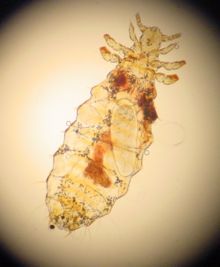蝨亞目
蝨亞目[註 1](學名:Anoplura),又名吸蝨亞目[1]蝨目或裸尾目,舊作原蝨目(Siphunculata),原為蝨毛目之下的一個亞目,現在是囓蟲目之下七個亞目之一。有約15科50屬540種[2]。體型較小,無翅,身體扁平,寄生於毛髮處,有善於勾住毛髮的足(攫握器)。虱為漸變態發育,終生寄生於宿主體表,以宿主血液、毛髮、皮屑等為食。這個亞目的物種的宿主只佔所有哺乳類動物的兩成,並不存在於餘下的八成物種[3]。除了對宿主的皮膚引起刺激,也是多種透過血液傳染疾病的帶病者。
| 蝨亞目 | |
|---|---|

| |
| Linognathus setosus (Linognathidae) | |
| 科學分類 | |
| 界: | 動物界 Animalia |
| 門: | 節肢動物門 Arthropoda |
| 綱: | 昆蟲綱 Insecta |
| 目: | 囓蟲目 Psocodea |
| 亞目: | 粉囓蟲亞目 Troctomorpha |
| 下目: | 小嚙蟲下目 Nanopsocetae |
| 小目: | 蝨毛小目 Phthiraptera |
| 總科: | 蝨亞目 Anoplura Leach, 1815 |
| 科 | |
| 多樣性 | |
| 15個科 | |
| 異名 | |
| |
寄生於人體的虱有至少三個物種,主要以宿主血液為食,其若蟲每日吸血1次,成蟲每日吸血數次。
分類
編輯2000年代後期,根據分子生物學及形態學的研究確認了蝨毛目與囓蟲目是近親,而蝨毛目其實是從粉囓蟲亞目演變而成的[4][5],因此這兩個目應該重組成為囓蟲總目(Psocodea,又名嚙總目[6])[7]。從此蝨亞目成為了囓蟲目之下的一個亞目,蝨毛目取銷。
根據《布魯斯的昆蟲分類表》,蝨目分為下列六個科:
- 海獸蝨科 Echinophthiriidae:又名棘虱科
- 象虱科 Haematomyzidae
- 獸蝨科 Haematopinidae:又名血虱科[1]
- 新毛蝨科(新顎蝨科)Neolinognathidae
- 蝨科 Pediculidae
- 陰蝨科 Phthiridae
但現時這六個科已重新分類,蝨亞目現時包括以下15個科:
- 海獸蝨科 Echinophthiriidae
- Antarctophthirius
- Antarctophthirus Enderlein, 1906
- Antarctophthirus callorhini (Osborn, 1899)
- Antarctophthirus carlinii Leonardi, Poljak, Carlini, Galliari, Bobinac, Santos, Marquez & Negrete, 2014
- Antarctophthirus lobodontis Enderlein, 1909
- Antarctophthirus mawsoni Harrison, 1937
- Antarctophthirus microchir (Trouessart & Neumann, 1888)[8]
- Antarctophthirus ogmorhini Enderlein, 1906
- Antarctophthirus trichechi (Bohemann, 1865)
- 海獸虱屬 Echinophthirius Giebel, 1871
- Echinophthirius horridus (von Olfers, 1816)[9]
- Latagophthirus Kim & Emerson, 1974
- Lepidophthirus Enderlein, 1904
- Proechinophthirus Ewing, 1923
- 松鼠蝨科 Enderleinellidae
- 獸蝨科 Haematopinidae :又名血虱科[1]
- 鉤蝨科 Hamophthiriidae
- 鉤虱屬 Hamophthirius Mjoberg, 1925
- Hamophthirius galeopitheci Mjoberg, 1925
- 鉤虱屬 Hamophthirius Mjoberg, 1925
- 甲脅蝨科 Hoplopleuridae
- 土豬蝨科 Hybothiridae
- 毛蝨科 Linognathidae :又名鄂虱科[1]
- 駱蝨科 Microthoraciidae (微胸蝨科)
- 新毛蝨科 Neolinognathidae (新顎蝨科)
- 蠻豬蝨科 Pecaroecidae
- 猿蝨科 Pedicinidae
- 蝨科 Pediculidae
- 陰蝨科 Phthiridae
- 細毛蝨科 Polyplacidae :在鼠類身上出現
- 驢蝨科 Ratemiidae (馬蝨科)
注釋
編輯參考文獻
編輯- ^ 1.0 1.1 1.2 1.3 吸血虱(Sucking Lice). 動物衛生監督交流. [2011-08-23]. (原始內容存檔於2015-02-12) (中文(簡體)).
- ^ Durden, L.A; Musser, G.G. The Sucking Lice (Insecta: Anoplura) of the World: A Taxonomic Checklist with Records of Mammalian Host and Geographical Distributions (PDF). Bulletin of the American Museum of Natural History. 1994, (218): 1–90 [2024-03-05].
- ^ Piotrowski, F. (1992): Anoplura (echte Läuse). de Gruiter; 61 pp. (page 8)
- ^ Yoshizawa, K.; Johnson, K. P. Morphology of male genitalia in lice and their relatives and phylogenetic implications. Systematic Entomology. 2006, 31 (2): 350–361. doi:10.1111/j.1365-3113.2005.00323.x.
- ^ Johnson, K. P.; Yoshizawa, K.; Smith, V. S. Multiple origins of parasitism in lice. Proceedings of the Royal Society of London. 2004, 271 (1550): 1771–1776. PMC 1691793 . PMID 15315891. doi:10.1098/rspb.2004.2798.
- ^ 梁維仁. 昆蟲分類學-科博館參訪心得 (PDF). 中興大學昆蟲學系. 2012-05-29 [2014-08-30]. (原始內容存檔 (PDF)於2020-10-06) (中文(繁體)).
- ^ Bess, Emilie, Vince Smith, Charles Lienhard, and Kevin P. Johnson (2006) Psocodea. Parasitic Lice (=Phthiraptera), Book Lice, and Bark Lice. Version 8 October 2006 (under construction). http://tolweb.org/Psocodea/8235/2006.10.08 (頁面存檔備份,存於網際網路檔案館) in The Tree of Life Web Project, http://tolweb.org/ (頁面存檔備份,存於網際網路檔案館)
- ^ Antarctophthirus microchir. Parasite of the Day. [2024-03-12]. (原始內容存檔於2024-03-12).
- ^ Echinophthirius horridus. Parasite of the Day. [2024-03-12]. (原始內容存檔於2024-03-12).
外部連結
編輯- 維基物種上的相關資訊:蝨亞目
- Solenopotes capillatus, little blue cattle louse (頁面存檔備份,存於網際網路檔案館) on the UF / IFAS Featured Creatures Web site
- VectorBase homepage for Pediculus humanus (genome browser, downloads and more)